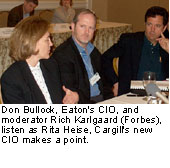
|
|
|
 |
|
 |
Service and Support: From Cost Reduction to Revenue Generation
Thought Leadership Summit on Digital Strategies February 11, 2003 - Durham, NC Is a service a cost center or revenue opportunity? How do you collaborate with value chain partners to offer services? |
||
|
Press Release
Agenda
List of Participants
Discussion Guide
Overview Article
|
|||||
Increasingly, traditionally product manufacturing and retail companies are putting forward services as a part of their offerings to customers. "The need for service offerings is clear," says Hans Brechbühl, executive director of Tuck's Center for Digital Strategies. "The question is how you transition from a mainly product-oriented company to the right service offerings. There are tremendous opportunities for cross-company collaboration in both determining and offering the right services, but the challenges of both internal change and external collaboration are significant."
Here are some key learnings from the summit that CIOs and other senior leadership should keep in mind as they move into the rich area of services:
- Moving from customer satisfaction to customer loyalty is vital and very tied to customer emotions. Services can be a key to creating great customer experiences that address unarticulated needs, provide a total solution instead of just a product and generate positive customer emotions;
- Services are perhaps tougher to offer because in many services (and few products) customers can directly affect quality and cost through their actions - companies should institute customer control systems while offering customers choices in the areas of least importance and lowest operational impact;
- Deciding how to offer a service is an important organizational decision for a product-centric company. Evaluating the proper place in an organization from which to offer a service requires three things:
- Clearly determining the type of service proposed (failure recovery, product augmentation, adjacent space service, etc.) and whether it is a cost center or a revenue opportunity
- Understanding the relationship of the proposed service to current products and services (including how tangible the service is)
- Objectively evaluating your own organizational structure and culture;
- Regardless of where you decide to house your service, you must create a culture in which it can thrive. Creating a service culture demands five actions:
- Providing a vision for the service, a common objective established from the top
- Establishing a common service terminology
- Creating a mechanism for sharing stories
- Embedding the right incentive metrics rewarding service initiatives
- Insisting on daily customer contact from appropriate senior management;
- Customer touch points through services are increasingly desired by many product companies, but as many service companies can tell you, you can only handle so much customer contact - design the touch points well, know when you have the competence internally and when not, and use technology to your advantage;
- Using digital technology to empower customers must move beyond self-service to service enhancements. Coaxing customers on-line can reduce cost, but may also have many unintended consequences such as erosions in customer loyalty and profitability. Digital strategies that improve the customer experience for existing products and services while also reducing costs are the focus of leading CIOs.
As Mark Hillman from GM stated, "For General Motors, which is classically known as a product company, service growth is very significant. If you look at our mainstream vehicle business, and there's certainly a variation in growth rates across the world, but generally speaking it's relatively low growth or flat growth market. But that core business for us also drives the opportunity to do more around services which have a much higher growth rate potentially and higher profitability than some of the base business."
![]()
| To link to the Thought Leadership Summit on Digital Strategies website, click here. |